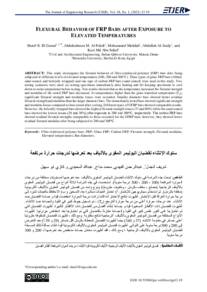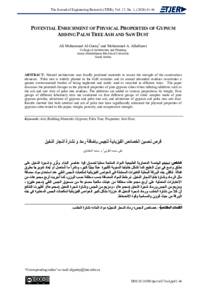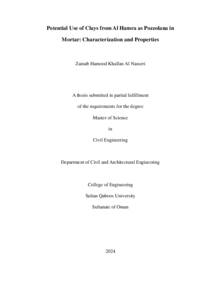Document
Flexural behavior of FRP bars after exposure to elevated temperatures.
Identifier
DOI: 10.53540/tjer.vol18iss1pp12-19
Source
The Journal of Engineering Research (TJER), v. 18, no. 1, p. 12-19.
Contributors
Al-Fahdi, Abdulrahman M., Author
Meddah, Mohammed., Author
Al-Saidy, Abdullah., Author
Sohel, Kazi Md Abu., Author
Other titles
سلوك الانثناء لقضبان البوليمر المقوى بالألياف بعد تعرضها لدرجات حرارة مرتفعة.
Country
Oman.
City
Muscat
Publisher
College of Engineering, Sultan Qaboos University.
Gregorian
2021-10-06
Language
English
English abstract
This study investigates the flexural behavior of fibre-reinforced polymer (FRP) bars after being subjected to different levels of elevated temperatures (100, 200, and 300°C). Three types of glass FRP bars (ribbed, sand-coated, and helically wrapped) and one type of carbon FRP bars (sand-coated) were used in this study. Two testing scenarios were applied: (a) testing specimens immediately after heating and (b) allowing specimens to cool down to room temperature before testing. The results showed that as the temperature increased, the flexural strength and modulus of the tested FRP bars decreased. At temperatures higher than the glass transition temperature (Tg), significant flexural strength and modulus losses were recorded. Smaller diameter bars showed better residual flexural strength and modulus than larger diameter bars. The bars tested immediately after heating showed significant strength and modulus losses compared to bars tested after cooling. Different types of GFRP bars exhibited comparable results. However, helically wrapped bars showed the highest flexural strength losses (37% and 60%), while sand-coated bars showed the lowest losses (29% and 39%) after exposure to 200 and 300°C, respectively. The carbon FRP bars exhibited residual flexural strengths comparable to those of the GFRP bars; however, they showed lower residual flexural modulus after being subjected to 200 and 300°C.
ISSN
Online: 1726-6742
Print: 1726-6009
Arabic abstract
تبحث هذه الدراسة في سلوك الانثناء لقضبان البوليمر المقوى بالألياف بعد تعرضها لمستويات مختلفة من درجات الحرارة المرتفعة (100، 200، 300 درجة مئوية). تم استخدام ثلاثة أنواع من قضبان البوليمر المقوى بالألياف الزجاجية (مضلعة، مغلفة بالرمل، وملفوفة حلزونيًا) ونوع واحد من قضبان البوليمر المقوى بالألياف الكربونية (مغلفة بالرمل). تم تطبيق سيناريوهين للاختبار: الأول يتمثل في اختبار العينات مباشرة بعد التسخين، والثاني بعد السماح لها بالتبريد إلى درجة حرارة الغرفة قبل الاختبار. أظهرت النتائج أن زيادة درجة الحرارة تؤدي إلى انخفاض في مقاومة الانثناء ومعامل الانثناء للقضبان المختبرة. عند درجات حرارة أعلى من درجة حرارة التزجج (Tg)، تم تسجيل انخفاض كبير في مقاومة الانثناء ومعامل الانثناء. كما أظهرت القضبان ذات الأقطار الصغيرة مقاومة انثناء ومعامل انثناء أفضل من القضبان ذات الأقطار الكبيرة. أظهرت القضبان التي تم اختبارها مباشرة بعد التسخين خسائر كبيرة في القوة والمعامل مقارنة بالقضبان التي تم اختبارها بعد التبريد. سجلت القضبان الملفوفة حلزونيًا أعلى خسائر في مقاومة الانثناء (37% و 60%)، في حين أظهرت القضبان المغلفة بالرمل أقل خسائر (29% و 39%) بعد التعرض لدرجات حرارة 200 و 300 درجة مئوية، على التوالي. أما قضبان البوليمر المقوى بالألياف الكربونية، فقد أظهرت مقاومة انثناء متبقية مماثلة لتلك الخاصة بقضبان البوليمر المقوى بالألياف الزجاجية، لكنها سجلت انخفاضًا في معامل الانثناء المتبقي بعد التعرض لدرجات حرارة 200 و 300 درجة مئوية.
Category
Journal articles



